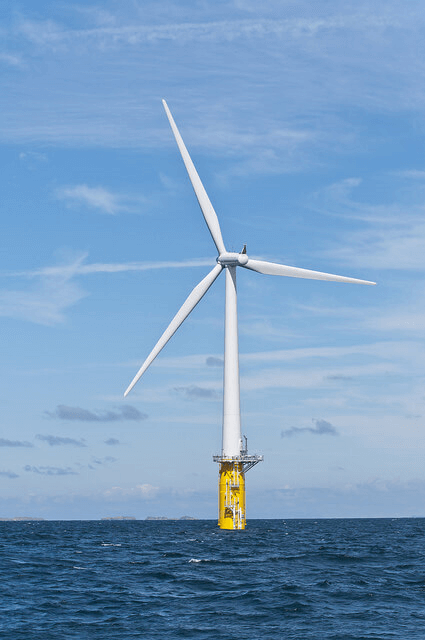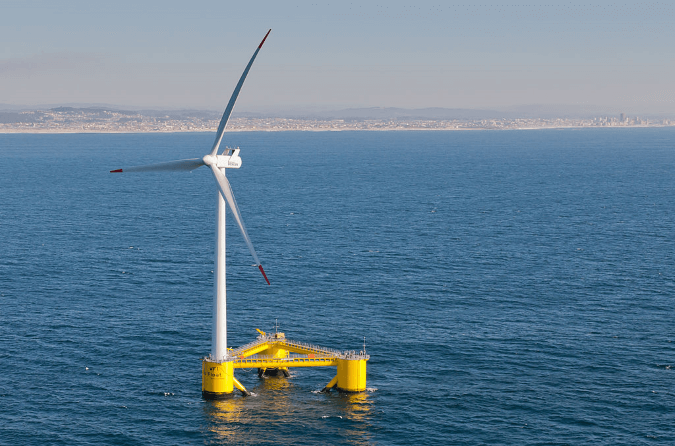Floating wind turbines appear to be a technology capable of further developing offshore wind by unlocking deep water areas that are currently not viable.
During All Energy 2015 conference last May in Glasgow a session titled ‘Floating Turbines’ was held where various floating turbine technologies and their potential for the growth of offshore wind were discussed.
In this article we summarise:
- Key information on two floating turbine technologies that were presented.
- Geographic areas where opportunities lie for this upcoming offshore technology.
- The benefits of floating turbines for developers and the offshore industry.
Floating Technologies
Various concepts have been presented and are currently under development. These include Hywind, WindFloat, Damping Pool and Pelestar TLP. Two that were presented and discussed at All Energy are Hywind and WindFloat.
Hywind – Statoil’s Floating Turbine Technology
Over the last few years Norwegian Statoil has been developing an innovative floating turbine technology called Hywind. Briefly, this is comprised of a simple substructure construction having a conventional 3-line mooring system. There are three stages in Statoil’s vision regarding Hywind technology; these are [1]:
Stage 1 – Hywind Demo: A 2.3 Megawatt (MW) floating wind turbine was installed in 2009, 10 kilometres off the south-west coast of Norway and is currently operational. The turbine has a hub height of 65 metres, a rotor diameter of 83 metres and an overall tip height of 106.5 metres above mean sea level.
Stage 2 – Hywind Scotland Park: Following the evaluation of Stage 1 Statoil is currently planning five 6 MW floating turbines off the Aberdeen coast. The turbines are planned to have a hub height of 78 metres, a rotor diameter of 154 metres and an overall tip height of 175 metres above mean sea level. The project is planned to be constructed in 2016/2017 and be operational in 2017.
Stage 3 – Large Scale Commercial Parks: Following Stage 2, the vision is to create large scale floating wind parks by expanding into deeper waters in Northern Europe, Japan and the USA. The first large scale project is to happen in 2020 whilst increasing the volume towards 2030.
 Figure 1: Hywind Demo Floating Turbine
Figure 1: Hywind Demo Floating Turbine
WindFloat – Principle Power’s Floating Turbine Technology
Over the last few years United States based company, Principle Power, has been developing an innovative floating turbine technology called WindFloat. In brief, this is comprised of a 3-column structure fitted with water entrapment plates at the base of each column. There are three phases in Principle Power’s vision regarding WindFloat technology; these are [2]:
Phase 1 – WindFloat Technology Demonstration: A 2.0 MW floating wind turbine was installed in October 2011, 5 kilometres off the coast of Aguçadoura in Portugal and is currently operational. The turbine is believed to have an overall tip height of 120.0 metres above mean sea level.
Phase 2 – WindFloat Pre-Commercial: Following the evaluation of Phase 1, Principle Power is looking into building demonstration scale wind parks up to 2018.
Phase 3 – WindFloat Commercial: Beyond 2018, the vision is to deploy the technology commercially on a global scale.
 Figure 2: WindFloat Technology Demonstration Floating Turbine
Figure 2: WindFloat Technology Demonstration Floating Turbine
The Opportunity for Floating Offshore Wind in the UK
The UK has been the world leader in offshore wind since October 2008. Approximately 4.2 Gigawatt (GW) – (1,184 turbines) are currently installed, 12.7 GW are currently in the planning system, and 10 GW are projected to be installed by 2020 [3].
Floating turbines appear to be important for the growth of offshore wind in the UK and especially Scotland because of [4], [5]:
- Access to currently non-viable areas in (40-60m and beyond water depths). In Scotland alone, 123 GW out of 169 GW are in waters depths greater than 60 metres.
- Reduction of offshore wind cost. The Energy Technologies Institute (ETI) has estimated that less than £85/MWh is achievable.
- Different technologies which are likely to approach commercial stage for large offshore wind parks in 2020 onwards.
- According to the ETI if 40 GW of Offshore wind is deployed by 2050, between 8 and 16 GW could be TLP based floating offshore wind.
The Opportunity for Floating Offshore Wind Globally
Outside the UK and especially Scotland, areas that could benefit from floating turbines include Northern Europe, Japan, and the USA among others.
The Benefits of Floating Turbines
There are many reasons why floating turbines make sense when particular conditions apply. Key reasons include:
- A competitive alternative for transitional water depth (40-60 metres).
- Exploitation of wind resource for deeper water > 60 metres.
- Develop larger offshore turbines further away from shore.
- Exploitation of sites with better wind conditions.
- Flexibility in site selection.
- Onshore assembly of the wind turbine.
Floating Turbines and Aviation/Radar Constraints
Floating turbines are still likely to be affected by various constraints as other offshore turbines. Offshore wind turbines can affect aviation and radar operations and raise planning objections. However, one of the advantages of floating turbines when compared to other offshore turbines is that micrositing or moving the turbines to avoid or minimise radar interference or other aviation constraints can often be an effective mitigation solution.
Conclusions
Floating wind turbines appear likely to grow in the future and in the next few years a number of currently developed technologies aspire to be used in large scale commercial offshore wind parks around 2020. There appears to be a lot of potential for growth in the UK (especially Scotland), Northern Europe, Japan and the USA.
References
[1] Hywind – status and next steps by Eirik Byklym. Presentation at All Energy 2015 Conference, Glasgow (07/05/2015).
[2] Enabling a Paradigm Shift for the Offshore Wind Industry by João Metelo. Presentation at All Energy 2015 Conference, Glasgow (07/05/2015).
[3] Offshore Wind, by RenewableUK (Last accessed 01/06/2015).
[4] Floating Offshore Wind – Scotland’s Opportunity by Johanna Yates. Presentation at All Energy 2015 Conference, Glasgow (07/05/2015).
[5] Potential for Floating Offshore Wind in the UK by Andrew Scott. Presentation at All Energy 2015 Conference, Glasgow (07/05/2015).
Image accreditations:
“Hywind” by Carl-Frederic Salicath via Flickr / CC BY-ND
WindFloat by Untrakdrover (Own work) via WikiMedia/ CC BY-SA 3.0 / image cropped and resized from original.
1 Comment
-
Author
A new report from the Carbon Trust published in June 2015 sets out the current state of the floating wind industry and outlines the opportunity for Scotland to take the lead in commercialising floating wind technology. You can read the full report at the URL provided below:
http://www.carbontrust.com/media/670664/floating-offshore-wind-market-technology-review.pdf
